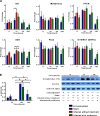Cost of surviving sepsis: a novel model of recovery from sepsis in Drosophila melanogaster
- PMID: 26791145
- PMCID: PMC4720623
- DOI: 10.1186/s40635-016-0075-4
Cost of surviving sepsis: a novel model of recovery from sepsis in Drosophila melanogaster
Abstract
Background: Multiple organ failure, wasting, increased morbidity, and mortality following acute illness complicates the health span of patients surviving sepsis. Persistent inflammation has been implicated, and it is proposed that insulin signaling contributes to persistent inflammatory signaling during the recovery phase after sepsis. However, mechanisms are unknown and suitable pre-clinical models are lacking. We therefore developed a novel Drosophila melanogaster model of sepsis to recapitulate the clinical course of sepsis, explored inflammation over time, and its relation to impaired mobility, metabolic disturbance, and changes in lifespan.
Methods: We used wild-type (WT), Drosomycin-green fluorescent protein (GFP), and NF-κB-luc reporter male Drosophila melanogaster 4-5 days of age (unmanipulated). We infected Drosophila with Staphylococcus aureus (infected without treatment) or pricked with aseptic needles (sham). Subsets of insects were treated with oral linezolid after the infection (infected with antibiotics). We assessed rapid iterative negative geotaxis (RING) in all the groups as a surrogate for neuromuscular functional outcome up to 96 h following infection. We harvested the flies over the 7-day course to evaluate bacterial burden, inflammatory and metabolic pathway gene expression patterns, NF-κB translation, and metabolic reserve. We also followed the lifespan of the flies.
Results: Our results showed that when treated with antibiotics, flies had improved survival compared to infected without treatment flies in the early phase of sepsis up to 1 week (81 %, p = 0.001). However, the lifespan of infected with antibiotics flies was significantly shorter than that of sham controls (p = 0.001). Among infected with antibiotic sepsis survivors, we observed persistent elevation of NF-κB in the absence of any obvious infection as shown by culturing flies surviving sepsis. In the same group, geotaxis had an early (18 h) and sustained decline compared to its baseline. Geotaxis in infected with antibiotics sepsis survivors was significantly lower than that in sham and age-matched unmanipulated flies at 18 and 48 h. Expression of antimicrobial peptides (AMP) remained significantly elevated over the course of 7 days after sepsis, especially drosomycin (5.7-fold, p = 0.0145) on day 7 compared to that of sham flies. Infected with antibiotics flies had a trend towards decreased Akt activation, yet their glucose stores were significantly lower than those of sham flies (p = 0.001). Sepsis survivors had increased lactate levels and LDH activity by 1 week, whereas ATP and pyruvate content was similar to that of the sham group.
Conclusions: In summary, our model mimics human survivors of sepsis with persistent inflammation, impaired motility, dysregulated glucose metabolism, and shortened lifespan.
Keywords: Akt; Drosomycin; Drosophila; Insulin; Recovery; Sepsis.
Figures







References
Grants and funding
LinkOut - more resources
Full Text Sources
Other Literature Sources
Molecular Biology Databases

